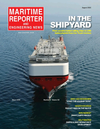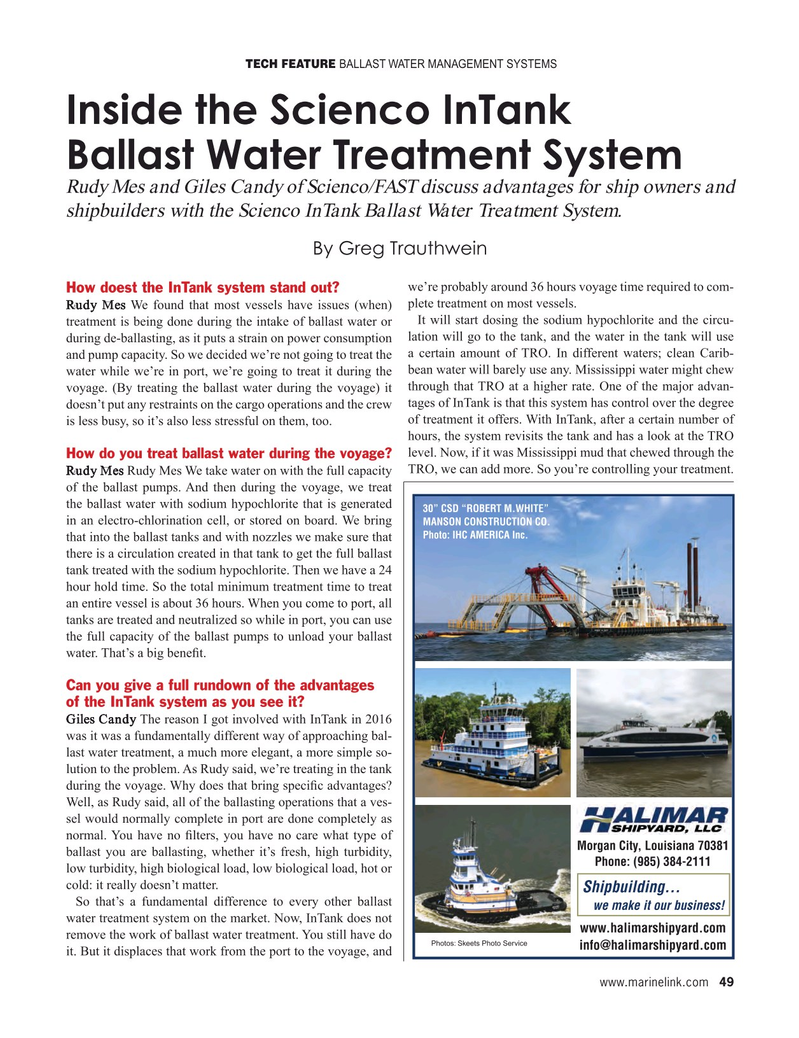
Page 49: of Maritime Reporter Magazine (August 2021)
The Shipyard Annual
Read this page in Pdf, Flash or Html5 edition of August 2021 Maritime Reporter Magazine
TECH FEATURE Ballast water management systems
Inside the Scienco InTank
Ballast Water Treatment System
Rudy Mes and Giles Candy of Scienco/FAST discuss advantages for ship owners and shipbuilders with the Scienco InTank Ballast Water Treatment System.
By Greg Trauthwein we’re probably around 36 hours voyage time required to com-
How doest the InTank system stand out?
Rudy Mes We found that most vessels have issues (when) plete treatment on most vessels.
It will start dosing the sodium hypochlorite and the circu- treatment is being done during the intake of ballast water or during de-ballasting, as it puts a strain on power consumption lation will go to the tank, and the water in the tank will use and pump capacity. So we decided we’re not going to treat the a certain amount of TRO. In different waters; clean Carib- water while we’re in port, we’re going to treat it during the bean water will barely use any. Mississippi water might chew voyage. (By treating the ballast water during the voyage) it through that TRO at a higher rate. One of the major advan- tages of InTank is that this system has control over the degree doesn’t put any restraints on the cargo operations and the crew of treatment it offers. With InTank, after a certain number of is less busy, so it’s also less stressful on them, too. hours, the system revisits the tank and has a look at the TRO level. Now, if it was Mississippi mud that chewed through the
How do you treat ballast water during the voyage?
Rudy Mes Rudy Mes We take water on with the full capacity TRO, we can add more. So you’re controlling your treatment.
of the ballast pumps. And then during the voyage, we treat the ballast water with sodium hypochlorite that is generated 30” CSD “ROBERT M.WHITE” in an electro-chlorination cell, or stored on board. We bring
MANSON CONSTRUCTION CO.
Photo: IHC AMERICA Inc.
that into the ballast tanks and with nozzles we make sure that there is a circulation created in that tank to get the full ballast tank treated with the sodium hypochlorite. Then we have a 24 hour hold time. So the total minimum treatment time to treat an entire vessel is about 36 hours. When you come to port, all tanks are treated and neutralized so while in port, you can use the full capacity of the ballast pumps to unload your ballast water. That’s a big beneft.
Can you give a full rundown of the advantages of the InTank system as you see it?
Giles Candy The reason I got involved with InTank in 2016 was it was a fundamentally different way of approaching bal- last water treatment, a much more elegant, a more simple so- lution to the problem. As Rudy said, we’re treating in the tank during the voyage. Why does that bring specifc advantages?
Well, as Rudy said, all of the ballasting operations that a ves- sel would normally complete in port are done completely as normal. You have no flters, you have no care what type of
Morgan City, Louisiana 70381 ballast you are ballasting, whether it’s fresh, high turbidity,
Phone: (985) 384-2111 low turbidity, high biological load, low biological load, hot or cold: it really doesn’t matter.
Shipbuilding...
So that’s a fundamental difference to every other ballast we make it our business!
water treatment system on the market. Now, InTank does not www.halimarshipyard.com remove the work of ballast water treatment. You still have do
Photos: Skeets Photo Service [email protected] it. But it displaces that work from the port to the voyage, and www.marinelink.com 49
Halimar Shipyard MR Aug2020.indd 1 8/7/2020 10:29:08 AM

 48
48

 50
50
